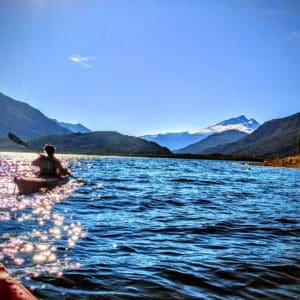Whether you’re on vacation or lucky enough to live in a place with plenty of sunshine, one of the biggest threats is overexposure to the sun.
Along with short term inconveniences like sunburn, prolonged and extended exposure to sunlight can do serious damage over time.
Approximately 80% of your skin’s aging is due to extended exposure. Sun or “age spots” are dark blotches on your skin exacerbated by sunlight.
Melasma is another symptom of too much time in the sun. Although experts aren’t positive what causes these white and grey spots that appear, there is a correlation between time in the sun and their appearance.
While there are some new methods to reversing or minimizing the damage, it’s not possible for your skin to recover entirely.
How Sun Exposure Damages The Skin
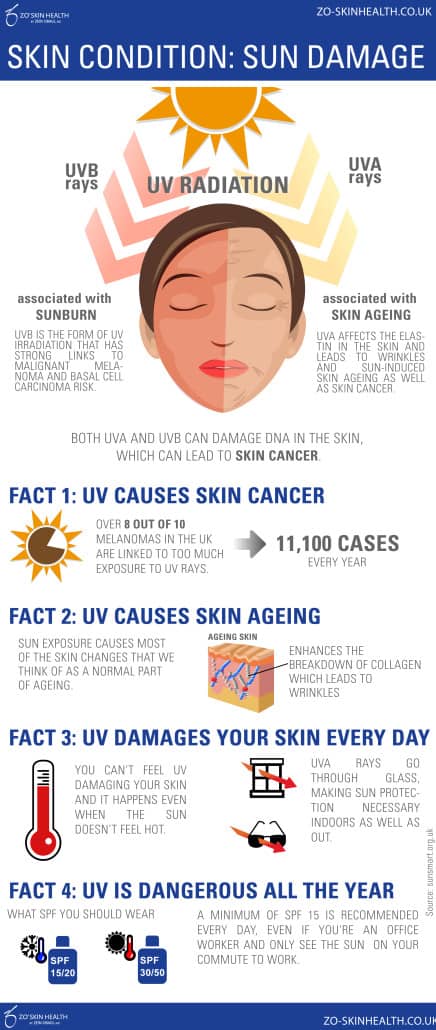
There are three types of UV (ultraviolet) rays transmitted by the sun. The first, UVC doesn’t reach the planet’s surface, but the other two – UVA and UVB – can penetrate your skin.
The most obvious ailment is redness, irritation, and burning skin. But beneath the skin’s outer layer, too much exposure to UV rays can alter your DNA and prematurely age your skin. DNA alterations can eventually result in skin cancer.
How soon you develop a sunburn depends on several factors. Exposure, skin tone, and the intensity of the sun can all contribute. In most situations, the sun is at its most intense levels between 10 a.m and 2 p.m. Your location matters too. Rays can reflect off the surface of water, sand, or snow and magnify, leading to a quicker burn.
While redness and irritation are the most common symptoms of sunburn, severe burns can have more deleterious effects. Swelling and blisters are signs of a bad sunburn and in extreme cases, flu-like symptoms can emerge. Fever, chills, nausea, and physical weakness are other signs of critical burns.
If you begin to have severe symptoms, consult a health care professional immediately. Chills, excruciating pain, blisters covering more than 20% of the body, or a temperature of more than 102 degrees are all serious symptoms.
Watch for signs of dehydration like dry mouth, extreme thirst, reduced urination, or fatigue. While recovering from your sunburn, minimize the amount of time you spend in the sun as much as possible. Stay in the shade and wear light, loose-fitting clothing that covers your arms and legs to minimize UV rays.
In most cases, after a few days, the damaged skin starts to peel and itch as your body attempts to remove the skin damaged cells.
Sunscreen Ingredients
Look For…
There are a lot of different active ingredients in sunscreens. Not all countries classify the substance the same and have their own unique methods of approving the chemicals.
The U.S for example classifies sunscreen as a drug which leads to a slow approval rate for many. The best sunscreen protects against all UV rays without risk to the user or the environment. But this can be a tall order.
Of all the compounds, the one that covers the most bases is Mexoryl SX. It’s been proven to be an effective UV absorber and is great at preventing sun damage. There have been no side effects found in testing or long last effects. It is not approved for infants under six months, however.
In Europe, one of the most popular ingredients is Tinosorb S&M. It can protect against long and short rays, and is a stabilizer of other sunscreen filters, all while providing antioxidant benefits.
However, the product has not been approved in the U.S. The F.D.A has cited a lack of information as a justification. At this time, no long term health risks have been connected to the compound.
Avoid…
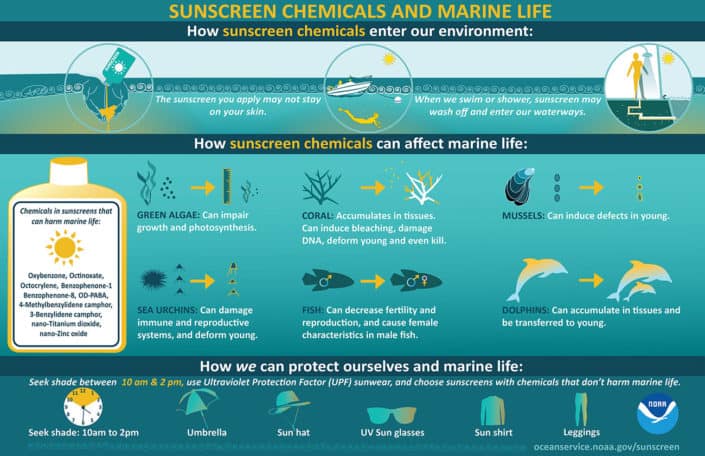
Not all sunscreen compounds are safe for you or the environment. In recent years, sunscreen has been linked to coral bleaching and DNA damage.
As sunscreen sloughs off the skin and into the water, the concentrated chemicals start to have negative effects on coral. Some sunscreen has been found to impair green algae growth and photosynthesis and accelerate coral bleaching.
Damage has been traced to animals that inhabit these areas. Fish have shown decreased fertility and dolphins have begun to transfer the chemicals to their young.
Some chemicals that have been linked to coral and wildlife damage are zinc oxide, octinoxate, and oxybenzone.
In fact, the state of Hawaii has decided to ban the use of oxybenzone and octinoxate to protect its coral reef.
Furthermore, some products can cause damage to those with sensitive skin such as oxybenzone. Others like titanium dioxide and zinc oxide can leave a white cast on those with olive or dark skin. Titanium dioxide may also be carcinogenic when in powder form.
While not directly harmful, oxybenzone can irritate those that have sensitive skin.
Sunscreen Ratings
All sunscreen products must list a Sun Protection Factor (SPF), a numerical scale that measures how well the sunscreen shields unprotected skin from sun exposure.
Those that pass certain tests may also advertise other protections like protecting against prematurely aging skin and how long it will last in the water.
SPF Definitions
- SPF 15: Blocks 93% of UVB rays
- SPF 30: Blocks 97% of UVB rays
- SPF 50: Blocks 98% of UVB rays
- SPF 100: Blocks 99% of UVB rays
Which SPF is Right for You
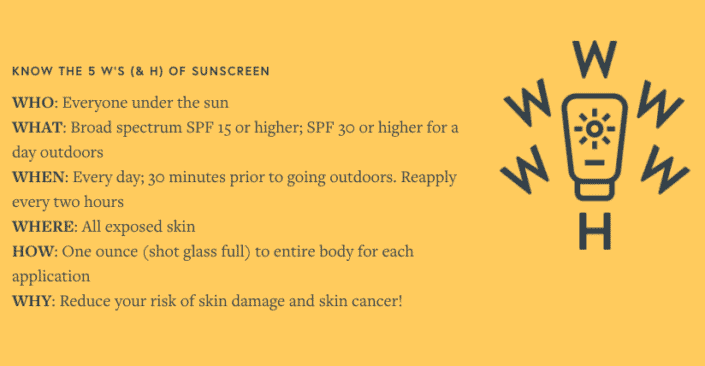
SPF 15 is the minimum rating that dermatologists recommend to protect your skin from sun damage. But as you go up the SPF scale, the difference in protection becomes minuscule. Once you cross the SPF 50 threshold, the ratings become essentially the same.
An SPF 100 may sound impressive, but nothing will keep out all rays, and the difference between 98 and 99% UVB ray protection is not substantial.
If you’ve had minimal sun exposure, it’s best to start with a higher SPF at the beginning.
It may be tempting to go straight for a dark tan and a lower SPF rating, but that tan can quickly turn red. It’s safer to start with a more protective SPF 50 sunscreen and work your way down the spectrum than try to recover and work your way up.
The strength of the sunscreen also has no bearing for how long it will maintain its effectiveness. A higher rating doesn’t mean it will last longer. The FDA (Food & Drug Administration) recommends that you reapply sunscreen every two hours to maintain effective protection.
If you plan on being in the water, make sure you select a waterproof brand without any substances that will damage coral or marine life. Also give your latest sunscreen application time to absorb into your skin before entering the water. It won’t do you much good if the water immediately washes it off. The length of time you should wait varies between 15 and 30 minutes depending on the source.
Broad Spectrum
Ultraviolet (UV) rays are transmitted on a variety of wavelengths. Most sunscreens protect specifically against one type of rays known as UVB.
Some sunscreens protect against the “broad spectrum” of wavelengths like UVA. UVA is responsible for premature aging in the skin and can also lead to skin cancer. Broad-spectrum protection is not on a numerical rating and instead is simply labeled on the bottle.
Water & Sweat Resistance
Even though some sunscreen brands are advertised as water or sweatproof, none are perfect.
Make sure you give your sunscreen plenty of time to absorb if you plan on swimming or sweating heavily. It’s also a good idea to apply it more often and more aggressively than you would if you plan on just laying out.
Sunscreen and Infants
The FDA does not recommend using sunscreen on babies six months and younger. But infants are more susceptible to harmful sun side effects than adults and children.
Keep infants out of direct sunlight between 9 a.m and 4 p.m. Use wide brim hats and protective clothing if they have to be in the sun for any period of time.
For children older than six months, refer to the application information on the bottle.
Treating Sunburn
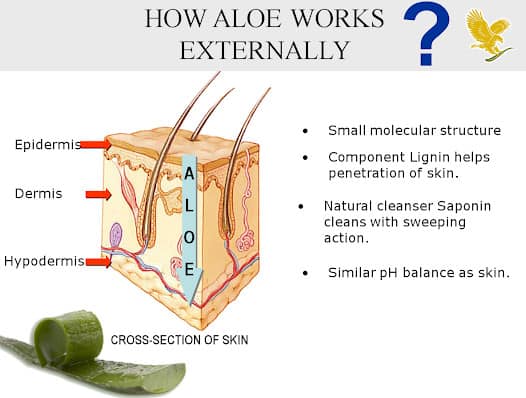
In the event that you do get burned, there are several treatments to help your skin recover, ease the pain, and minimize the redness and inflammation.
Try applying a cool compress to the afflicted area or take a cool bath to alleviate the burning sensation.
There are also several creams and gels on the market. The most common of these is aloe vera, a herbal gel found in the aloe plant that cools and soothes the skin while also rehydrating. Menthol and camphor are other popular supplements. If you refrigerate your gel or cream before applying, the application will feel better.
Regardless of how you treat your burn, be sure to take in plenty of fluids. Burned skin can quickly dehydrate your body.
Supplements, especially vitamin D, will help keep your skin strong and healthy. Inspect your body often looking for itching and bleeding. If you suspect something is wrong, see a dermatologist as soon as possible. Skin cancer is treatable if caught early enough.
Tanning Beds
The idea of a “base tan” or a “healthy glow” are misnomers.
Tanning beds rely on the same UV rays as the sun to darken your skin and can lead to the same wrinkling or accelerate skin cancer.
If you really want a tan, consider using a spray-on tanning product.
Spray or Lotion
If spray is the only option available, by all means use it. But If you have the choice, select a lotion style sunscreen.
The most obvious benefit is it’s much easier to tell how much you’re applying. With spray, it’s harder to get a gauge for how much you’re putting on.
In most cases, those using sprays put on less since they only spray for a few seconds.
How to Apply Sunscreen Properly
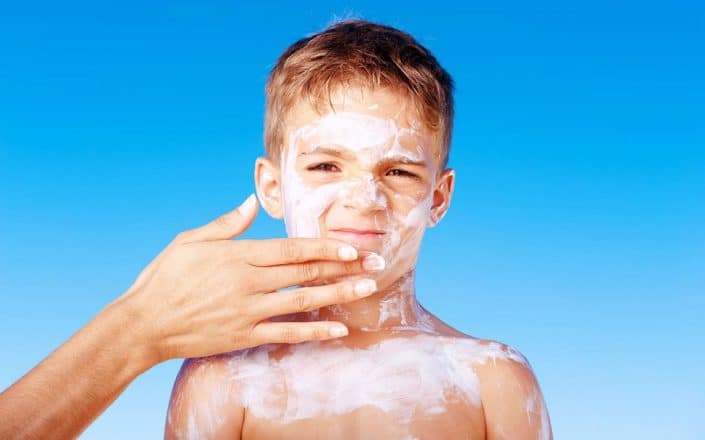
Don’t be thrifty! Lay sunscreen on nice and thick to ensure proper coverage. Have a friend apply it in hard to reach places for you. For your face, dot sunscreen onto your face instead of squeezing a dollop on your hands first. This will help it absorb quicker and more evenly.
We’ve already mentioned the importance of letting the sunscreen sit on your skin before going out. But if you must go out immediately, use sunscreen that includes zinc oxide. Remember that zinc-oxide-based sunscreen can have deleterious effects on coral reefs and leave white blotches on the skin. So do your best to plan ahead.
Backcountry Sunscreen
If you’re going to be out for multiple days with little or no opportunity to get inside, you’ll want one of the strongest and most sweat-resistant sunscreens.
Zinc-oxide-based sunscreen goes on thick and handles sweat and moisture better than most. It leaves a more pale effect on the skin as we discussed, but since you probably won’t be coming in contact with many coral reefs on your backpacking trip, you don’t have to worry about that side effect.
Sun Exposure in the Southern Hemisphere
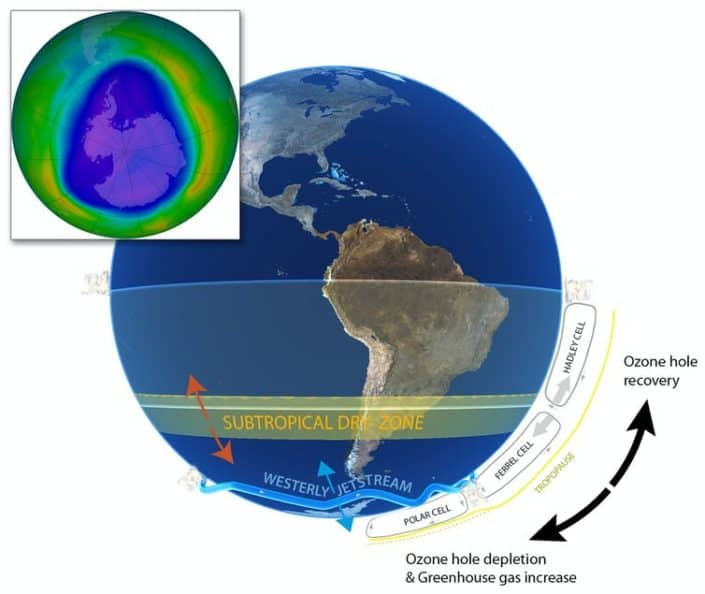
Much of the damage to the planet’s ozone layer has congregated in the southern atmosphere.
Without this layer absorbing UV rays, the strength of the sun and potential for skin damage is magnified. The hole stretches over 28.3 million square miles with the most vulnerable countries being Australia, New Zealand, South Africa, Chile, and Argentina.
While the ozone layer does slowly regenerate and steps have been made to limit damage, if you live or are visiting one of these countries, you should increase your sunscreen usage. Apply it more often and use a higher SPF brand.
How to Choose Sunscreen: Conclusion
Whenever you’re outside with intense sunshine, be sure that you have the proper sunscreen that’s safe for you and the planet.
You may not tan as quick, but your skin will thank you.
Did we miss anything? Have anything else to share? Let us know in the comments below.

